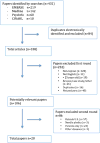Anxiety in Youth With Type 1 Diabetes
- PMID: 27663096
- PMCID: PMC5743322
- DOI: 10.1016/j.pedn.2016.08.007
Anxiety in Youth With Type 1 Diabetes
Abstract
Problem: Mental health conditions are prevalent in youth with type 1 diabetes (T1D). Anxiety symptoms and depressive symptoms are highly correlated and are two of the most prevalent mental health conditions in youth in the general population. The detrimental effect of depressive symptoms in youth with T1D has been well documented, but the effects of anxiety symptoms are not well understood.
Eligibility criteria: Studies were included if they were published between 1990 and 2015, and evaluated anxiety symptoms in a population of youth with T1D.
Sample: A total of 20 studies were identified from a sample of 338 papers.
Results: Anxiety symptoms were prevalent in youth with T1D. Anxiety symptoms were associated with higher glycosylated hemoglobin (HbA1c) levels, poorer self-management and coping behaviors, depressive symptoms, fear of hypoglycemia, and lower blood glucose monitoring frequency. State anxiety and trait anxiety symptoms affected health outcomes differently. Girls were at a higher risk of anxiety symptoms than boys.
Conclusions: Anxiety symptoms in youth with T1D have detrimental effects on health outcomes, including self-management, quality of life, and HbA1c.
Implications: Future research should aim to improve our current screening and treatment practices.
Keywords: Anxiety; Anxiety symptoms; Mental health conditions; Type 1 diabetes.
Copyright © 2017 Elsevier Inc. All rights reserved.
Figures
References
-
- American Diabetes Association. Statistics about diabetes. 2014 Retrieved from http://www.diabetes.org/diabetes-basics/statistics/
-
- Bernstein CM, Stockwell MS, Gallagher MP, Rosenthal SL, Soren K. Mental health issues in adolescents and young adults with T1D prevalence and impact on glycemic control. Clinical Pediatrics. 2013;52:10–15. - PubMed
-
- Bradley BP, Mogg K, Falla SJ, Hamilton LR. Attentional bias for threatening facial expressions in anxiety: Manipulation of stimulus duration. Cognition & Emotion. 1998;12:737–753.
-
- Briery BG, Rabian B. Psychosocial changes associated with participation in a pediatric summer camp. Journal of Pediatric Psychology. 1999;24:183–190. - PubMed
-
- Crawford TN, Cohen P, Midlarsky E, Brook JS. Internalizing symptoms in adolescents: Gender differences in vulnerability to parental distress and discord. Journal of Research on Adolescence. 2001;11:95–118.
Publication types
MeSH terms
Substances
Grants and funding
LinkOut - more resources
Full Text Sources
Other Literature Sources
Medical



